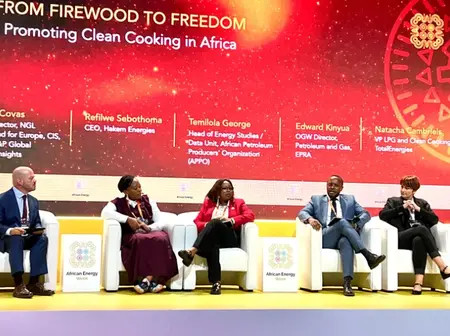Kenya has been ranked among Africa’s leading consumers of liquefied petroleum gas (LPG), underscoring the country’s rapid shift towards cleaner and healthier cooking solutions.
A report by the Energy and Petroleum Regulatory Authority (EPRA), released for the financial year ending June 2025, shows that Kenya’s LPG consumption has surged to 7.9 kilograms per person.
Speaking at the Africa Energy Week in Cape Town, South Africa, EPRA Chief Executive Engineer Edward Kinyua lauded the progress and outlined the government’s National LPG Growth Strategy.
“We have made great progress as a country. However, making LPG more accessible and affordable will be critical to achieving universal clean cooking,” Kinyua said.
The strategy focuses on expanding LPG access in public learning institutions, encouraging piped supply in residential areas, and supporting the distribution of cylinders to low-income households.
According to the report, Kenya’s total LPG consumption climbed by 15 per cent to 414,861 metric tonnes during the year, driven by targeted interventions in homes, schools, and the growing use of autogas.
Kenya’s energy transition has also been reflected in its electricity sector. The country recorded its highest peak power demand in five years, hitting 2,316.2 megawatts, while total electricity generation grew by six per cent to 14,472 gigawatt-hours. Notably, nearly 80 per cent of this power came from renewable sources, with geothermal energy continuing to lead the way.
Household electricity use rose by 13 per cent to 3,640.32 gigawatt-hours, while small commercial consumers increased usage by 11.5 per cent to 1,913.26 gigawatt-hours. Street lighting grew significantly, and e-mobility energy consumption tripled to 5.04 gigawatt-hours as electric vehicles became more common.
Large industries saved about Ksh 1.438 billion by shifting 180.3 gigawatt-hours of their power consumption to off-peak hours under the Time-of-Use tariff.
Kenya’s regional energy ties also strengthened. The completion of the 400 kV transmission line to Tanzania, along with increased electricity imports from Ethiopia, Uganda, and Tanzania, has enhanced grid flexibility and helped meet the country’s growing demand.
Kenya’s ranking as a leading LPG user and its expanding clean energy portfolio highlight a transformative moment. The shift from smoky kitchens to gas stoves and from fossil fuels to renewable power is positioning the country as a model for sustainable energy progress in Africa.
The move away from firewood and charcoal is not just about convenience. Clean cooking protects the environment by reducing deforestation and improves public health by cutting indoor air pollution, which has long been linked to respiratory illnesses.
This technology is part of a growing field aiming to make sperm and eggs outside of the body, known as in vitro gametogenesis.
The approach is still at the level of scientific discovery rather than clinical use, but the vision is to help couples who cannot benefit from IVF (in vitro fertilisation) because they don’t have the sperm or eggs to use.
It could help older women who no longer have viable eggs, men who don’t produce enough sperm or people whose cancer treatment has left them infertile.
The field also rewrites the rules of parenthood. The technique described today does not have to use a woman’s skin cells – it could also use a man’s.
That opens the door to same-sex couples having children that are genetically related to both partners. For example, in a male same-sex couple, one man’s skin could be used to make the egg and a male partner’s sperm used to fertilise it.
“In addition to offering hope for millions of people with infertility due to lack of eggs or sperm, this method would allow for the possibility of same-sex couples to have a child genetically related to both partners,” said Prof Paula Amato, from Oregon Health and Science University.

Leave a Reply